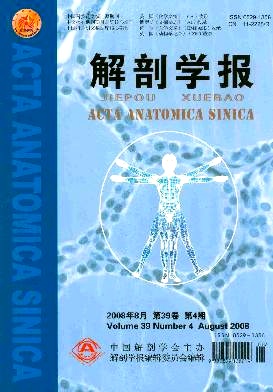|
|
Effect of astragalus injection on the expression of Caspase-3 after hypoxia/hypoglycemia and reoxygenation in hippocampal neurons of rats
2011, 42 (1):
14-21.
doi: 10.3969/j.issn.0529-1356.2011.01.003
Objective To investigate the effect of astragalus injection on the expression of Caspase-3 interrelated by apoptosis after hypoxia/hypoglycemia and reoxygenation in hippocampal neurons of rats. Methods Divided the hippocampal neurons cultured for eight days into four groups: normal control group(normal), hypoxia/hypoglycemia and reoxygenation group(model), astragalus injection solution group(solution) and astragalus injection group(astragalus). All groups were treated with reoxygenation after deprived of oxygen and glucose for 30 minutes except normal group. Immunohistochemistry was used to measure the number of Caspase-3 positive neurons, EM>in situ/EM> hubridization and RT-PCR were used respectively to measure the expression of Caspase-3 mRNA after hypoxia/ hypoglycemia and reoxygenation 0,0.5,2,6,24,48,72,120 hours. The experiment was repeated 6 times. Results The results of immunohistochemistry were similar to that in EM>in situ/EM> hybridization. It could be observed in normal control group that hippocampal neuronal nucleolus were integrated, cellular tuber was distinct and cytokinesis were dyed by yellow a lot; It could be observed in hypoxia/hypoglycemia and reoxygenation group that hippocampal neuronal nucleolus were crimple, cellular tuber was shrinked, large numbers of cytokinesis were dyed by yellow and there were yellow granules. Compared with normal control group, the numbers, the percentage and the average absorbance(AEM>A/EM>) of Caspase-3 protein and Caspase-3 mRNA positive neuronal cells every time points increased obviously in the hypoxia/ hypoglycemia and reoxygenation group except 0 hour and 0.5 hours(EM>P/EM><0.05), and peaked at 24 hours. The change of neuronal in configuration, numbers,percentage and the average absorbance of Caspase-3 mRNA positive neuronal cells in astragalus injection solution group were accorded with hypoxia/ hypoglycemia and reoxygenation group(EM>P/EM>>0.05). Compared with hypoxia/hypoglycemia and reoxygenation group, the numbers, the percentage and the average absorbance of Caspase-3 mRNA were less obviously in the astragalus injection group except 0 hour and 05 hours(EM>P/EM><0.05). RT-PCR result showed that compared with normal control group, the average absorbance of expression of Caspase-3 mRNA in hippocampal neurons of rats every time points increased obviously in hypoxia/hypoglycemia and reoxygenation group except 0 hour and 0.5 hours (EM>P/EM><0.05), and peaked at the 24th hour; Compared with hypoxia/hypoglycemia and reoxygenation group, the average absorbance of expression of Caspase-3 mRNA every time points in astragalus injection solution group had no obvious change, however the average absorbance of expression of Caspase-3 mRNA in hippocampal neurons of rats every time points decreased obviously in the astragalus injection group except 0 hour and 0.5 hours(EM>P/EM><0.05). Conclusion Astragalus injection could inhibit the expression of Caspase-3 after hypoxia/hypoglycemia and reoxygenation, accord
Related Articles |
Metrics
|


